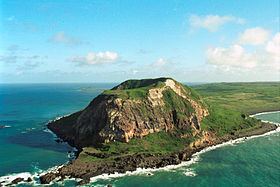Last eruption May 2, 2012 Prominence 169 m | Elevation 169 m | |
 | ||
Us marines raise american flag on top of mount suribachi in iwo jima japan durin hd stock footage
Mount Suribachi (JPN.: 摺鉢山, Suribachiyama) is a 169 m high mountain at the southwest end of the island Iwo Jima (now officially Iō-tō) in the northwest Pacific Ocean, under the administration of Ogasawara Subprefecture, Tokyo Metropolis, Japan.
Contents
- Us marines raise american flag on top of mount suribachi in iwo jima japan durin hd stock footage
- Map of Mount Suribachi Ioto Ogasawara Tokyo 100 2100 Japan
- Hike to mount suribachi
- Geology
- History
- References
Map of Mount Suribachi, Ioto, Ogasawara, Tokyo 100-2100, Japan
The mountain's name derives from its shape, resembling a suribachi or "grinding bowl." It is also known as the "Mount Pipe" (JPN: パイプ山, paipu-yama), since the sulfur gas and water vapor that rolls in from the summit, alongside the rest of the island, give the appearance of a smoking pipe when viewed from the sea.
Joe Rosenthal's famous photograph Raising the Flag on Iwo Jima was taken at the mountain's peak.
Hike to mount suribachi
Geology
Geologically, the mountain is a cinder cone of andesite, formed by volcanic activity. It is thought that the mountain is a dormant vent to a still active volcano (designated Iō-tō, the name of the island as a whole). From 1889 to 1957, the Japanese government recorded 16 eruptions on the peak. One eruption lasted for 65 minutes, and created a crater with a diameter of 35 meters and a depth of 15 meters on the runway near the former World War II airfield. Most recently, the Japanese Meteorological Agency reported that on May 2, 2012, a small eruption caused water discoloration to the northeast, and confirmed the appearance of a new fumarole.
History
During World War II, the Japanese built underground tunnel and bunker systems in and on Mount Suribachi. In February 1945, United States Marines invaded the island and initiated a major battle. For the United States, Iwo Jima was an important strategic point between the United States and mainland Japan, a status that resulted in severe fighting that took the lives of nearly 7,000 Americans and 20,000 Japanese.
One of the six soldiers who lifted the flag was obscured and not recognized. The soldier was later found to be Cpl. Harlon Block and he had died in less than a week after the photo. Shot by photographer Joe Rosenthal, this photo was taken of the famous photograph of the raising of the flag.
The film Sands of Iwo Jima, directed by Allan Dwan and starring John Wayne in 1949, follows a United States Marine rifle squad preparing for battle at Iwo Jima. The films Letters from Iwo Jima and Flags of Our Fathers, directed by Clint Eastwood in 2006, treat the theme of this Pacific battle and present the positions of both belligerents in this conflict.
